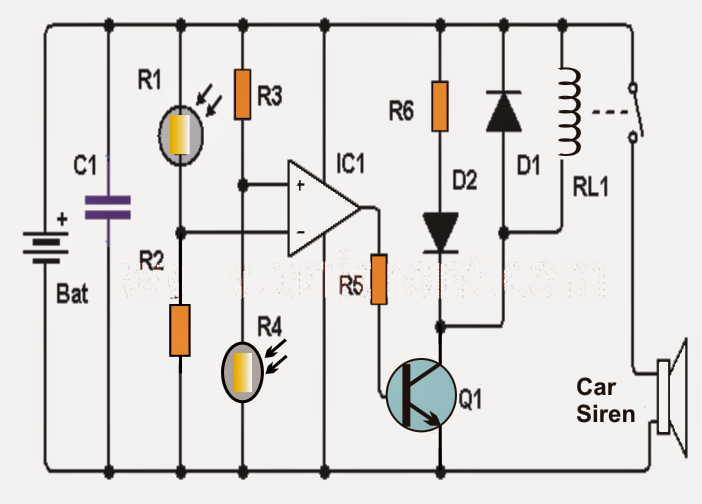This shadow detector circuit functions making use of two LDRs and successfully finds the variance between the light levels and generates a loud audible alert siren.
In circuits which utilizes a single LDR (photoresist), the detection might not be as sharp as with two LDRs mentioned right here.
Operational information of the shadow detector circuit might be analyzed given below:
The important elements of this circuit are the two LDRs along with the active functional amplifier, which features as a comparator.
As could be observed in the diagram, the inputs of the opamp are cautiously balanced utilizing alternately located LDRs across the corresponding supply rails together with the specific resistors.
The two resistors might be quite possibly replaced with presets for obtaining a fine adjustment choice and for providing the best possible balance and a suitable zero logic at the output of the opamp.
In standard light circumstances which is without shadow detected (no shade) the two LDRs have the ability to obtain the similar amount of light across the sensing input of the opamp which supplies a low logic level at the output of the IC.
In an event when considered one of the LDRs (for example R1) encounters a shadow or less light than the other (R4), leads to the voltage at the inverting input of opamp to go cheaper than in the non-inverting counterpart, leading to the logic at the output of IC to switch to a high logic.
The above steps triggers transistor Q1, which often triggers the LED and the relay. The LED enables to obtain a visual warning while the relay triggers a siren device.
Essentially you might want to place a semiconductor diode (D1) in identical with the relay, as revealed in the diagram, to guard the transistor Q1 from the relay reverse EMFs.

Points to be noted:
- The circuit is driven by 9 volt lead acid battery or any equivalent SMF battery.
- The LDRs ought to be positioned with a separation of about 3cm. for an optimal reply in order to stay away from wrong activating.
Parts list for the offered shadow detector circuit
- 1 Operational amplifier: LM741 (IC1)
- 2 LDRs (photoresistor / LDR) (R1, R2)
- 1 NPN transistor 2N2222 or similar (Q1)
- 1 1N4007 diode (D1)
- 1 red LED diode (D2)
- 9 volt relay (RL1)
- Two 10K resistors (R3 and R4)
- 1 1K resistor (R5)
- 1 resistors 470 (R6)
- 1 100 nF capacitor (C1)
Thank you very much.